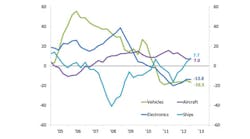It’s an axiom in defense circles that “no plan survives contact with the enemy.” In our case, no government spending reduction plan seems to survive contact with Congress. Their decision to delay the looming sequestration cuts by two months has not been helpful in clearing the air of uncertainty that has settled over Washington and many defense industries. Defense contractors are planning on reductions in billable man hours or reductions in project scope. It should not be hard to reach mandated cuts without gutting our defense capabilities, given the incredible redundancy in contracts, research and operations that exist between the branches of the military.
See Also: Make Your Move Blog
Other changes are known, such as the force reductions occurring in Afghanistan. The effects of drawdowns have led to industries shedding jobs even before sequestration was set to kick in. Major companies across the industry have also announced plant closures and more stringent cost-cutting measures. Even many in the Pentagon’s civilian workforce could be facing pink slips this year. The nomination of a defense secretary who has described the department’s budget as “bloated” does not signal a reversal of the more austere fiscal environment.
National Defense Expenditures
New orders for defense capital goods are currently 17.9% below their year-ago level (annual basis), even before sequestration is implemented. Internal trends in the data indicate that spending will end the year only 7% below the 2012 level. We do not expect new orders to return to their 2010 heights in the foreseeable future. Overall national defense expenditures on a GDP basis have fallen 3.1% below last year, reflecting the “belt-tightening” mood of today. As the chart illustrates, defense expenditures are showing significant variation between sectors. The pace of growth of spending on aircraft has slowed to 7.0%, but overall spending is still increasing. Gains in spending on ships are also holding, currently at 7.7% year-over-year growth. Expenditures for vehicles and electronics remain well below year-ago levels, -16.5% and -13.8%, respectively.
The economic realities of our global partners and allies will be a crucial factor in the defense sector’s health during 2013. Readers can expect Europe to slowly deal with its sovereign debt crisis and avoid a political breakup. However, we expect that austerity-minded budget ministers will continue to chip away at their national defense expenditures, even as the region becomes further entangled in combatting extreme elements in Africa. The United Kingdom has announced it could be removing up to 15,000 service members from the Army, Navy and Air Force and 25,000 civilian jobs. Other nations are also reevaluating their role in the development of the F-35 Joint Strike Fighter, citing cost overruns and projected maintenance burdens.
In light of the current environment, the Pentagon’s “Annual Industry Capabilities” report released in 2012 states that officials will be implementing an “aggressive” data collection and analysis effort (termed S2T2) to identify defense industry sectors that may be at risk due to spending constraints. Leaders will rely on “normal market forces” to provide research and manufacturing capabilities, but they vow to intervene should market activity fall short of requirements. The Pentagon’s study signals a new seriousness about the health of the industry. This suggests that INDUSTRYWEEK readers need to be keenly aware of efficiency requirements to satisfy both internal and external demands.






